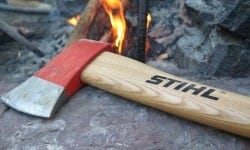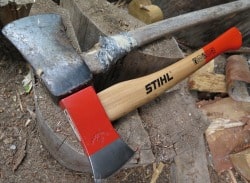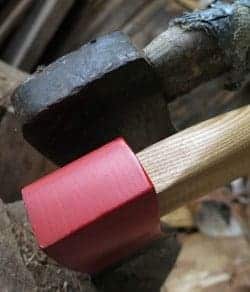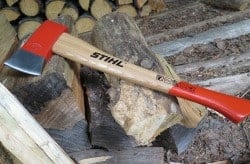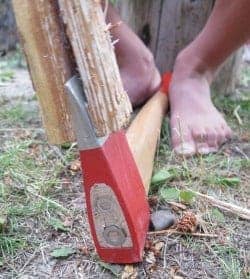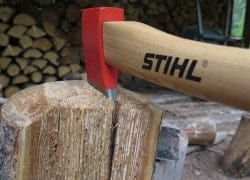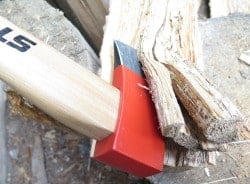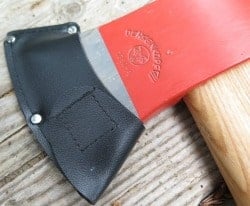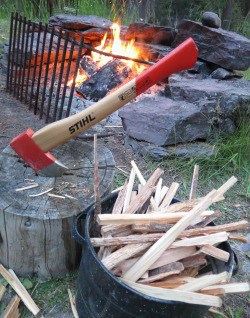In addition to building some of the world’s best chainsaws, the Stihl company also makes…or at least brands some
The Stihl Pro Splitting Hatchet is known as the PA20 and retails for about $55 which feels like a screaming deal given my preference for handmade Swedish axes and hatchets that cost two to four times more than the Stihl. Of course large Stihl Splitting Mauls do command three-digit prices, but that just makes the Stihl Pro Splitting Hatchet seem a better deal.
SKIP AHEAD
First Principles
The first time you get your hands on a Stihl Pro Splitting Hatchet you will know this is not your grandpa’s hatchet.
Related: Gränsfors Bruks Hand Hatchet Review
The physics of using the Stihl Pro Splitting Hatchet is two-fold. The first is that aggressive wedge that pushes apart any wood that comes in contact with the sharp bit. And second, the excessive weight of the head in motion (force = mass x acceleration) compared to a common hatchet makes plowing the head into the workpiece a decisive and final action. Unless working with a hardwood or trying to blast your way through a tough knot, the Stihl Pro Splitting Hatchet will send wood flying east and west when you have the sun to your back.
History Lesson
Stihl builds chainsaws. It does not manufacture its own axes. Instead it uses the services of the oldest axe forge in
Related: Survival Axes
The Stihl Company traces its roots to the shallow side of the last century. The year 1926 marks the beginning of the Stihl chainsaw, an electric model of all things, and a mere 30 years before Andreas Stihl was born in Zurich, Switzerland in 1896. Prior saw machines such as those crazy bicycle/rowing machine contraptions appeared earlier than 1900, but had few recognizable features in common with even the most primitive of chainsaws.
In 1929, a gas-powered tree felling machine appeared with the Stihl name. The 101 pound six-horsepower monster marked a turning point in wood cutting tools, and is considered Stihl’s first chainsaw. Do note however, that even though considered massive by today’s two-handed standards, the tree felling machine was a good five pounds lighter than its electricity-powered older brother.
Can You Handle It?
Hickory is the go-to wood for most high end axes and hatchets. So why would the Stihl Pro Splitting Hatchet have a
But while we discuss the handle of the Stihl Pro Splitting Hatchet, there is no arguing about how overbuilt it is. From
Also Read: CRKT Chogan T-Hawk Review
Some features to note besides the thick neck are the accented toe of the handle (the lower portion of the grip on the cutting edge side, and the heel (the grip part opposite of the toe). There is a definitive swell on the toe side and plenty of rise on the heel side to keep the Stihl Pro Splitting Hatchet in your hand even after a powerful single handed swing. Stihl brands the Pro Splitting Hatchet with characteristic Stihl orange paint on the lower portion of the handle, and on the majority of the axe head from cheek to butt. And if that weren’t enough Stihl for you, in large bold black capital letters 3/4ths of an inch tall is STIHL prominently printed on the left side of the handle.
Kindling the Amazon
There are two highly functional ways to use the Stihl Pro Splitting Hatchet including slamming the Stihl into the
Related: Crovel Elite Review
Compared to a full-sized forest axe or a 30” four-pound splitting maul, this Stihl Pro Splitting Hatchet is a lightweight, but the same way an armored Hummer is a lightweight compared to an MRAT or Bradley. It’s all a matter of perspective and nimbleness. The biggest difference between the Stihl Pro Splitting Hatchet and it’s full-sized relatives is that the Stihl Pro Splitting Hatchet works fine in one hand or two. But running a bigger tool in one hand is dangerous at best. Way too much can go wrong when doing medium and small tasks with a large, long, unbalanced tool.
On softer woods, the Stihl Pro Splitting Hatchet can literally be dropped onto the work piece slicing it down the
When not in use, a fairly feeble bit cover is included that barely hangs onto the head with a touch of velcro. The blade
Many splitting hatchets and axes have a metal collar that protects the handle neck just below the head. The steel ringing the wood will take blows much better than the wood alone. It’s understandable that this Stihl Pro Splitting Hatchet would not have the added cost of the collar, but if I can find an aftermarket solution I might try it out. Sure, perfect accuracy during chopping would be the perfect solution, but other than that, a metal collar is the next best thing.
Also Read: 11.5 Bug Out Bag Mistakes That Aren’t
One other small negative is that the finish work on the Stihl Pro Splitting Hatchet is not to the highest of standards. Plenty good for anything this hatchet is used for, but a close inspection will detect very minor imperfections on the head that indicate a few cut corners during manufacture. Additionally, the grain pattern is many degrees off ideal although the “massivity” of the handle more than makes up for any grain rotation. But again, at fifty bucks, this is a good deal from any angle.
Plus Size
The Stihl Pro Splitting Hatchet is on my Bug In list since unless I can make a couple trips to my bug out location, or
In the end, the Stihl Pro Splitting Hatchet is an amazing camp tool that certainly earns its keep due to the efficiency it reduces the size of wood rounds and quarters. And it quickly becomes the go-to tool when maintaining the fuel supply for your campfire. In its reverse configuration, the Stihl Pro Splitting Hatchet is a safe tool for even the youngest of the fire maintainers, and when launched at wood with the speed and control of adult arm muscles, the Stihl Pro Splitting Hatchet blasts its way through with the precision of a squad of Marines. In other words, when you need your rounds blown apart and kindling piled up right now, the Stihl Pro Splitting Hatchet is your best friend.


